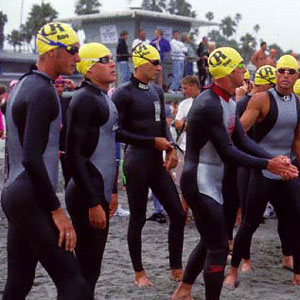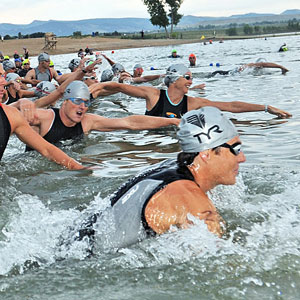The Panic Room

Many, many triathletes have experienced sudden anxiety in the open water swim leg of their races. Do we know just how frequently this occurs? No. However if you ask a roomful of triathletes, "how many of you have experienced a panic attack swimming?" A lot of them will likely raise their hands. One of the common and natural fears that many people associate with open water swimming, is the fear of drowning. In the past few years triathlon swim fatalities are becoming more conspicuous due to heightened mainstream press coverage, as well as social media discussion. In August, 2008, the Washington Post ran an article about the heightened visibility of fatalities that seem to be occurring during the swim leg of triathlons. The author, physician David Brown, opined that afflicted swimmers could have suffered "panic attacks" and consequent drowning. Since that time, there have been infrequent but steady reports of swim fatalities in smaller local races, as well as deaths in higher profile, large triathlons like the 2011 NYC Triathlon (2 deaths), IM NYC 2012 and IM CDA, 2012.
Etiology Remains Fuzzy
Unfortunately the etiology (medical speak for "underlying cause") of triathlon swim deaths remains unclear. Limited autopsy data from deceased triathletes has remained inconclusive. Opinions (both informed and less informed) about causation has ranged from drowning, to myocardial infarction (heart attack), to arrhythmia (irregular heartbeat), to more exotic medical so-called "zebras" like swimming induced pulmonary edema, aka SIPE (pulmonary fluid congestion), and vasovagal neurocardiogenic syncopy (sudden fainting related to water immersion).
Devising a plan to either prevent these fatalities, or at least to ensure the most aggressive rapid response, remains daunting, particularly without determination of a valid cause. However given this significant handicap, it remains incumbent on race directors, national governing bodies (like USAT), coaches, and athletes themselves to try to identify, and address all potential causative factors; triathletes’ wellbeing is at risk.
The purpose of this article is not to address and rectify all of the potential factors that can contribute to triathlete swimming distress and fatalities. There are a number of interventions which are being discussed. Some of these proposed measures include:
– Athlete pre-participation screening (ie cardiac screening, swimming competence testing)
– Improving swim course safety and setting minimum standards regarding temperature, water placidity
– Changing start procedures to wave or time trial starts
– Improving emergency response (rapid identification and evacuation of, and medical intervention) for distressed swimmers.
The Anxiety Factor
Open water related swimming anxiety remains an overlooked "wild-card" factor that may be involved in these rare but catastrophic events. However, even if anxiety does not turn out to play a role in swim deaths the ability to control open water swimming anxiety is a skill all triathletes must master in order to remain safe, to enhance enjoyment, and to maximize individual performance. Furthermore, if a triathlete develops a serious medical condition during the swim, there is little doubt that controlling anxiety may be the difference between rescue and potential death.
In the 1999 edition of the Hawaiian Ironman, former Ironman World Champion Greg Welch found himself in a serious predicament just 20 minutes into the swim. He relates on his website how he suddenly became short of breath (while in 3rd place), and needed to stop several times and hold onto a nearby lifeguard’s surfboard. It turns out that Welch had developed a potentially fatal cardiac condition called ventricular tachycardia (which, although eventually treated, ultimately forced him to retire from the sport). If Welch was a poor swimmer, and/or was not near a lifeguard, and/or panicked, he might very well have lost consciousness and drowned.
Both accomplished as well as neophyte swimmers can suffer from panic during a triathlon swim. Former world class Olympic distance triathlete and current elite coach Siri Lindley spoke about getting hit and dunked during an ITU World Cup race in 2000 which caused her to panic and slow down, losing the front pack, the race, and her chance to participate in the inaugural Olympic triathlon in Sydney. A former University of Texas swimmer once related to me how he started his first triathlon leading the swim aggressively, but he suddenly became inexplicably disorientated and scared when he arrived at the first turn buoy, needing to stop completely. An experienced age group triathlete who had been a lifeguard in her earlier years vividly described the experience of having a panic attack during a race: "About 50 yards out, the cold water hit my body like a punch to the gut and I began to hyperventilate. I started having a flashback to my near-drowning incident when I was eight years old. I inadvertently crawled on top of another woman swimming by, and she popped up and threw me off, and I was on my own. Each time I put my head down I felt claustrophobic as the darkness and seaweed seemed to envelop me."
Almost all athletes in all sports experience per-race jitters at the start of a competition or race. However there is good logic to contend that this anxiety is appreciably heightened for triathletes during the swim leg, where they are not only starting a race with a sudden surge of adrenaline, but are in a disorienting environment sometimes cold, murky, deep and turbulent—all in the context of close physical contact with other competitors.
There is also no doubt that the normal physiological "fight-or flight" response that panicked triathletes experience can be dangerous if an athlete has underlying medical conditions like asthma, advanced coronary artery disease, or an irregular heart beat. The combination of the extreme environmental stress of an open water triathlon start, and the presence of underlying medical conditions, can be a recipe for disaster for an at-risk triathlete.
Steps to Prevent Open Water Panic
Many triathletes can improve their psychological preparation to race, but particularly in the swim leg. Whether we are new triathletes or pros, there are several practical steps we can all take to enhance our ability to feel more comfortable and in control during the triathlon swim.
1) Understanding the Physiology and Neurophysiology of Anxiety: When we become fearful about a potential threat to our safety and well being, we become anxious, and there is a predictably natural and adaptive physiological response to this. Our heart rate increases; we breath more deeply; our muscles become tremulous; and we start to sweat and feel "cold and clammy" as our blood vessels shunt our blood supply away from our skin and intestinal system towards our more vital organs. Our central nervous system responds to fear as well. We feel "scared," and become exceptionally alert; all of our senses are heightened. Our prefrontal cortex, which is the rational decision making part of our brain slows, while our "911 center" (the amygdala, hypothalamus, pituitary and adrenal glands) suddenly seizes chemical control of directing our emotions and actions. The resulting surge of hormones like adrenaline and cortisol readies us for immediate, emergent action but, unfortunately, does not help us think more clearly. Ironically, during an acute stress response, our sense of logic and cognitive thinking processes are impaired. Hence the saying that "a triathlete loses 25 points off his/her IQ during a race!" Simply being aware of and understanding this natural fight-or-flight reaction as a normal, evolutionary, adaptive process is the first step in coping with it effectively.
2) Cognitive Restructuring: This idea forms the backbone of so-called cognitive behavioral therapy, which is an effective and widely used psychological tool for treating a number of anxiety and mood conditions including major depression and panic disorder. CBT, as it is known, relies on improving our ability to shift our thoughts away from false expectations of negative and catastrophic outcomes of day-to-day events, and toward more realistic outcomes. It is no different for triathletes. At trying times during races we can all get caught in the scary web of:
– mis-assumption ("my rival will beat me!")
– misperception ("this wetsuit is squeezing the air out of my lungs!")
– mis-attribution ("that son of a @$#!%& tried to dunk me during the swim!")
– distorted thinking ("I am in last place!")
3) Progressive Desensitization: Desensitization, or "exposure" training, is a validated technique used to treat a wide variety of anxiety conditions like panic disorder, social phobia, and obsessive compulsive disorder. Its principles can be easily applied to open water swimming, and the fear thereof. Simply put, desensitization involves the gradual and progressive exposure to situations that cause fear and avoidance. There are two types of exposure. The exposure process can be virtual (imaginary), or alternatively can involve real-life actual (in vivo) exposure to a fear invoking "stimulus". The advocacy of pre-race swim warm ups is predicated on the idea of physical and psychological desensitization, where an athlete is able to get his/her mind and body "used to" the immersion in water and in doing so, modulate his or her natural anxiety response. In psychological terms, gradual exposure helps athletes "habituate" to their fears, and become more immune to them.
4) Visualization: The function of visualization (also know as mental imagery) is actually to kindle the process of desensitization. Visualizing something that is fear-producing serves to "expose" us to anxiety-producing images and thoughts. We respond emotionally (and physiologically) to these images as if they are real, instead of imaginary. The term "visualization" is actually somewhat of a misnomer because optimally it should involve all five of our senses, not just our sight. So when a triathlete visualizes a swim he or she should feel the cold water, smell the weeds, taste the brine, and hear the starting horn and the splashing water.
Only time and diligent scientific inquiry will reveal the truth behind the causes of triathlon swim fatalities. Improving our awareness of anxiety and bolstering our mental skills to deal with it effectively may or may not turn out to play a role in preventing disasters from occurring; but it will lead to more enjoyable, safe and comfortable open water swimming.
[Jeff Anders, M.D. is a Clinical Assistant Professor of Psychiatry at The University of Wisconsin-Madison. He works with NCAA student athletes and serves on the University of Wisconsin Athletic Board. He is also a competitive masters triathlete and serves on the USAT panel currently reviewing triathlon swim fatalities.]


